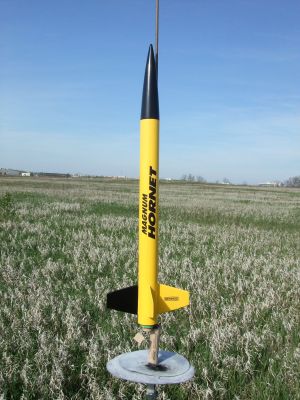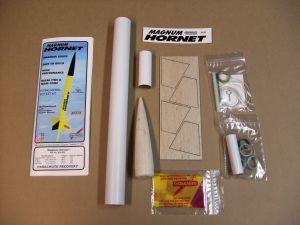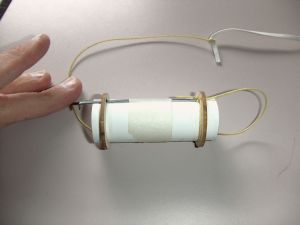| Construction Rating: | starstarstarstarstar_border |
| Flight Rating: | starstarstarstarstar |
| Overall Rating: | starstarstarstarstar_border |
| Diameter: | 1.33 inches |
| Length: | 19.80 inches |
| Manufacturer: | Semroc  |
| Skill Level: | 1 |
| Style: | Clone, Sport |

Brief:
Semroc has gone "retro repro" again, bringing out a modern reproduction of one of the last Centuri designs before the Damon Corporation consolidated their product line under the Estes brand. The kit, although a Centuri model, featured Estes parts in its day. The Semroc reproduction features laser-cut fins, a balsa nose cone, and upgraded Kevlar/elastic shock cord, plus includes a chute instead of the original streamer. It's a basic four-fin design, but with the flexibility to fly on either 18 or 24mm motors, you can lob it up over a small field or load in a D and send it into orbit.
Construction:
The parts list includes the following, all of excellent quality:
- BNC55AC Balsa nose cone (Estes Cherokee D style)
- BT-55 body tube
- BT-50 motor tube
- Laser-cut balsa fins
- Laser-cut thin cardboard centering rings
- Metal motor hook
- 12" plastic chute
- Kevlar/elastic shock cord
- Waterslide decal
- 18/24 adapter kit (motor tube, centering rings, metal hook, motor block)

Semroc has made one minor change to their instruction sheet format with this kit. The instructions remain printed on 8.5" x 11" paper, but instead of printing booklet style folded in half, you'll need to open up the whole thing flat. The left side of the sheets are perforated. The idea is that some builders will want to keep their instructions in a binder, and this makes it easy to do so and still read through the plans. It's probably a cool idea, but I have so many sets of instructions tucked away that it's probably a little too late to try and teach this old disorganized dog the trick of filing and neatness.
Overall, construction consists of about 30 steps over 3 full pages including illustrations and runs around 2 hours plus whatever time you invest in finishing. I built this side by side with the Magnum Sprint and found they are almost identical in build.
I started off with the motor mount, which consists of a simple 24mm tube with metal hook, motor block (20/50 centering ring) and a pair of thin centering rings. A loop of Kevlar slips under the metal hook to anchor the shock cord. The completed assembly is later glued inside the body tube flush with the aft end. Note that the motor hook and tube are sized only for D's, so if you are nutty enough to want to try an E, you'll have to swap out tube/hook.
The fins are symmetrical trapezoids mounted 1/2" forward of the aft end. Tube marking is via a marking guide on the instruction sheet with no lug line indicator. Lug placement is not that critical, but for aesthetics I'd have preferred a lug line included on the pattern (and a wraparound guide is easier for me). I tacked the fins on with medium CA then applied wood glue fillets.
Tacking on the launch lug and putting the screw eye on the nose cone wraps up the main construction.
 Because this is a fairly small/light model, a 24mm motor could be a little excessive. Therefore, a neat little adapter is included that supports 18mm motors. This adapter is a standard 18mm motor tube, block, and metal hook but with 3 centering rings. One of these rings has a cutout to allow the metal hook to open out of the way for removing the motor. If you place the centering rings carefully per the instructions, what you'll get slides perfectly into the BT-50, locking in place through the outer motor hook, and the 18mm motor is held in place by the inner hook.
Because this is a fairly small/light model, a 24mm motor could be a little excessive. Therefore, a neat little adapter is included that supports 18mm motors. This adapter is a standard 18mm motor tube, block, and metal hook but with 3 centering rings. One of these rings has a cutout to allow the metal hook to open out of the way for removing the motor. If you place the centering rings carefully per the instructions, what you'll get slides perfectly into the BT-50, locking in place through the outer motor hook, and the 18mm motor is held in place by the inner hook.
Finishing:
Finishing is a breeze although the stock paint scheme does require a very tiny bit of masking. The main body got a couple coats of gray primer after the standard Elmer's Fill 'n' Finish for spirals and grains. I then followed up with Rustoleum yellow. After allowing a couple days to cure, I masked off all but one fin and the nose and then hit those with gloss black.
The waterslide decals are minimal but add a nice touch and are excellent quality and are easy to work with.
Construction Rating: 4 out of 5
Flight:
For the first flight, I was looking at winds holding steady at 12-15 mph and gusting to 20, so the thought of chasing this for the expected drift of a 24mm motor was out of the question. I was surrounded by lake, trees, and soccer games so needed to minimize the drift to about 150 yards.
Thankfully, this comes with a handy little 18mm adapter so I was able to quickly load up a B6-4 for the first flight. I flew off a 3' length of 3/16" rod, and this rocket held its own against the wind very nicely, with just a hint of weathercocking. I didn't get much altitude with the B6-4 (maybe a couple hundred feet), but it would at least remain in the park. The -4 delay in this instance was perfect.
Recovery:
The 12" plastic chute is certainly up to the task, and I was able to recover this with no problems.
Flight Rating: 5 out of 5
Summary:
PROs: Classic design/tribute and great versatility. Can fly on large or small fields with A-D motors (potentially even 24mm F's).
CONs: None to speak of.
Overall Rating: 4 out of 5
Other Reviews
- Semroc Magnum Hornet By Eldred Pickett (August 1, 2009)
This was my first Semroc kit, so it was all new. It's a reproduction of an old Centuri kit with a few updates. There is an exploded-view diagram so you can see how the pieces go together. It also serves as a parts list showing how many of each part should be there. The parts were well laid out. The fins came on a laser-cut balsa sheet. This rocket also has a balsa nose cone for all your ...
- Semroc Magnum Hornet By Matthew Bond (July 21, 2009)
Centuri Engineering Company was started in the early 60s and was one of the early pioneers in the model rocket industry. Centuri was sold to Damon Corporation in the late 60s and maintained their product line separately from Estes until 1983. The Magnum Hornet was produced by Centuri from 1980-1983 and is unique in that it was one of a handful of Centuri kits comprised entirely of Estes parts. ...
- Semroc Magnum Hornet By John "MAX" Venable (June 25, 2009)
Brief: A lightweight, fast flier possibly capable of supersonic speed. Construction: This baby was a fun build. I loved every minute of it. The kit contains high quality parts. A straightforward build, but I tweaked it. This kit was built entirely with epoxy with microballoons for added strength and sandability, so she can fly on AeroTech E-30s. I replaced the balsa fins with ...
- Semroc Magnum Hornet By Jason Orosco (May 31, 2009)
Brief: I'll try and repeat what's in the other reviews, the Semroc Magnum Hornet is Retro-Repro of the Centuri Magnum Hornet with a 18mm motor adapter and 12" cute replaces the Streamer and Kevlar ® thread/elastic shock cord replaces the rubber band from the old Magnum Hornet. Construction: The instructions are well written and easy to follow with quality parts, what ...
- Semroc Magnum Hornet By Peter Stanley (May 24, 2009)
Brief: The Magnum Hornet is a Semroc Retro-Repro of a Centuri model. It is designed for 24mm motors but includes an 18mm adapter. Recovery is via 12" parachute. I ordered my kit from Semroc directly and had it within two days. Construction: The kit includes a balsa nosecone, one BT-55 body tube, a 3/16" launch lug, water slide decals, an elastic shock cord, Kevlar ...
- Semroc Magnum Hornet By Jeff Lane (May 12, 2009)
Brief: Chan's build experience exactly fit my own so I'll try not to repeat. The Magnum concept is simple: large motor, small rocket, and it actually makes more sense today than it did when originally marketed. I got my kit from Apogee, and it was damage-free. Construction: It is extremely easy to build and all the components are of high quality. Smooth, perfectly formed nose ...
 |
 |
Flights
 |
 |
M.G. (August 12, 2009)
 |
 |
D.F. (June 21, 2009)